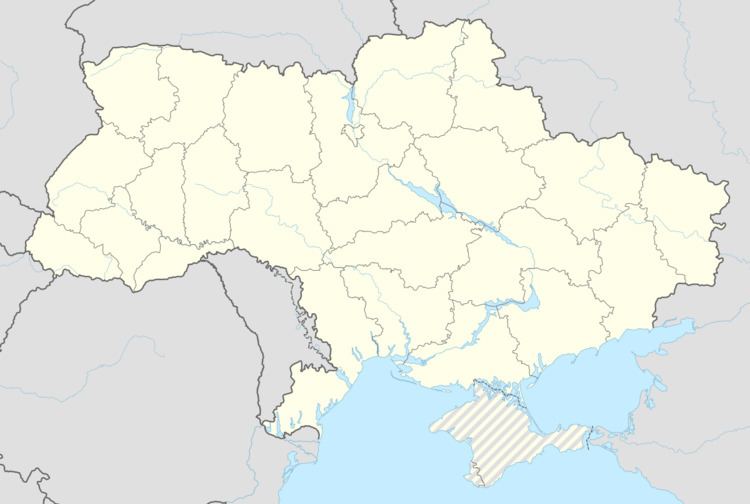Number 24 (as of 1991) | ||
 | ||
Created 27 February 1932 (85 years ago) (1932-02-27) Areas 8,100 km (3,126 sq mi) (Chernivtsi) – 33,300 km (12,860 sq mi) (Odessa) | ||
An oblast (Ukrainian: область), in English referred to as a region, refers to one of Ukraine's 24 primary administrative units. Ukraine is a unitary state, thus, the regions do not have much legal scope of competence other than that which is established in the Ukrainian Constitution and by law. Articles 140-146 of Chapter XI of the constitution deal directly with local authorities and their competency.
Contents
- General characteristics
- First oblasts of Ukraine in 1932
- Further division in 1937 38
- New creations and World War II territorial expansions in 1939 40
- Post World War II
- Constitutional provisions and authority
- Nomenclature
- Former Oblasts
- Renamed Oblasts
- References
Oblasts are further subdivided into raions (districts), ranging in number from 11 to 27 per entity.
General characteristics
In Ukraine the term Oblast denotes a primary administrative division. Under the Russian Empire and into the 1920s, Ukraine was divided between several Governorates. The term oblast itself was first introduced in 1932 by Soviet authorities when the Ukrainian SSR was divided into seven oblasts replacing the previous subdivision system based on okruhas and encompassing 406 raions (districts). The first oblasts were Vinnytsia Oblast, Kiev Oblast, Odessa Oblast, Kharkiv Oblast, and Dnipropetrovsk Oblast. Soon after that in the summer of 1932 Donetsk Oblast was formed out of eastern parts of Kharkiv and Dnipropetrovsk oblasts; in the fall of 1932 Chernihiv Oblast was formed on the border of Kiev and Kharkiv oblasts.
Between 1935-1938 there existed several newly created and self-governed special border okrugs located along the western border of the Soviet Union in Ukraine and Belarus. Upon liquidation of the okrugs in 1937-38 Kiev, Vinnytsia, Odessa, and Kharkiv oblasts were each split into four additional oblasts (Zhytomyr Oblast, Kamianets-Podilsky Oblast (later - Khmelnytsky), Mykolaiv Oblast, Poltava Oblast). Just before the World War II, the Donetsk Oblast was split into Stalino Oblast and Voroshylovhrad Oblast and the Kirovohrad Oblast was created out of portions of Kiev, Mykolaiv and Odessa oblasts.
During World War II Ukraine added eight additional oblasts of the West Ukraine and Bessarabia. Upon the occupation of Ukraine by the Nazi Germany the territory was split between General Government, Kingdom of Romania and Reichskommissariat Ukraine and carried out a completely different administrative division, see Reichskommissariat Ukraine. With the re-establishing of the Soviet power in the state after the war, the administrative division by oblast was resumed adding one more oblast—Zakarpattia. In 1954, the Crimean Oblast was transferred from the Russian Soviet Federative Socialist Republic to the Ukrainian SSR; parts of the surrounding oblasts were incorporated into the Cherkasy Oblast, while Izmail Oblast was absorbed by Odessa Oblast. In 1959, Drohobych Oblast was merged with Lviv Oblast.
Most of Ukraine's oblasts are named after their respective administrative centers, which are also the largest and most developed city in a given region. Each region generally consists of about one to two million of people, ranging anywhere from as low as 904,000 in Chernivtsi Oblast to 4.4 million in the eastern oblast of Donetsk. Each oblast is generally subdivided into about 20 raions (mean average, can range anywhere from 11 in Chernivtsi to 27 in Kharkiv and Vinnytsia Oblasts).
First oblasts of Ukraine in 1932
Further division in 1937-38
New creations and World War II territorial expansions in 1939-40
Post World War II
Constitutional provisions and authority
The Ukrainian constitution establishes Ukraine as a unitary state. The specific text of the constitution that refers to the territorial structure is as follows.
The territorial structure of Ukraine is based on the principles of unity and indivisibility of the state territory, the combination of centralisation and decentralisation in the exercise of state power, and the balanced socio-economic development of regions that takes into account their historical, economic, ecological, geographical and demographic characteristics, and ethnic and cultural traditions.
Each of Ukraine's oblasts have their own legislative and executive authority, most of which is subordinate to the central government authorities in Kiev. Each region is administered under laws passed by the Ukrainian government and the Constitution of Ukraine. Each region levies its own taxes and, in return, receive a portion of their budget from Kiev, which gives them a portion of the taxes they levy.
Executive power each of the oblasts (as well as in other subdivisions of Ukraine) are exercised by local elected administrations. The heads of local administrations are in turn appointed and dismissed by the President of Ukraine upon nomination by the Cabinet of Ministers. Since Ukraine is a unitary state, there is little true political power and weight that these local administrations actually hold. Carrying out their authorities, the heads of local administrations are accountable to the President and are subordinate to higher bodies of executive leadership.
Legislative power in the oblast governments is exercised by their respective oblast councils, which in turn supervise the activities of local administrations. They also have considerable budgets managed by an oblast council (Ukrainian: обласна рада) made up of people's deputies (representatives) voted into office in regional elections every 4 years, the last of which took place in 2010.
Nomenclature
The name of each oblast is a relative adjective, formed by adding a feminine suffix to the name of respective center city. E.g. Poltava is a center of Poltavs'ka oblast' (Poltava Oblast). Most of them are also sometimes referred to in a feminine noun form, following the convention of traditional regional place names, ending with the suffix "-shchyna". E.g. Poltava Oblast is also called Poltavshchyna.
Exceptions to this rule include:
